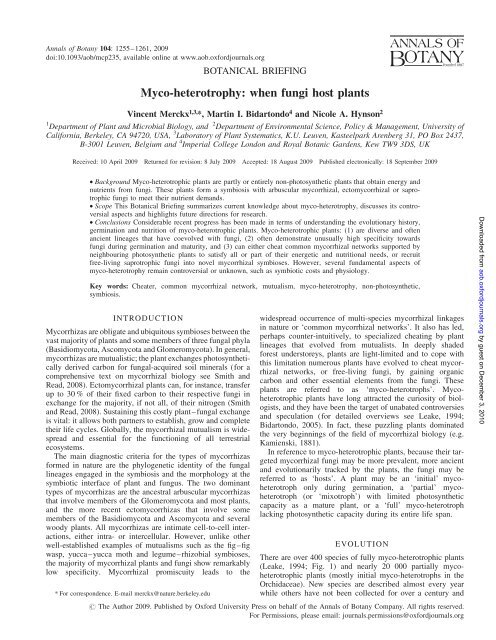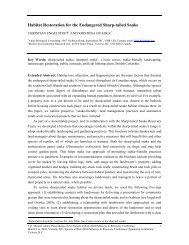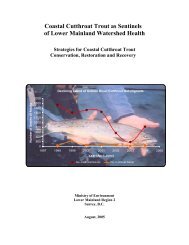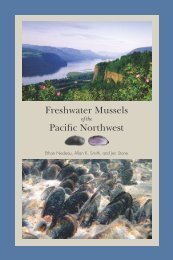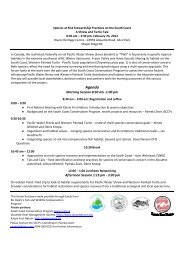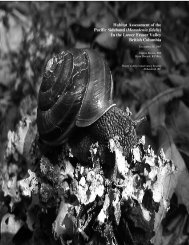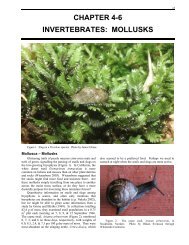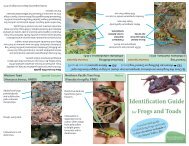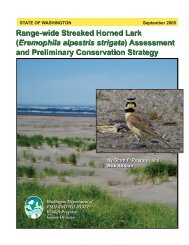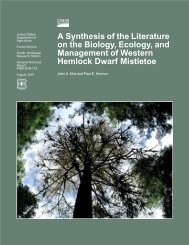Myco-heterotrophy: when fungi host plants
Myco-heterotrophy: when fungi host plants
Myco-heterotrophy: when fungi host plants
- No tags were found...
You also want an ePaper? Increase the reach of your titles
YUMPU automatically turns print PDFs into web optimized ePapers that Google loves.
1258Merckx et al. — <strong>Myco</strong>-<strong>heterotrophy</strong>: <strong>when</strong> <strong>fungi</strong> <strong>host</strong> <strong>plants</strong>the carbon and nitrogen isotope signatures of mycoheterotrophsto those of ectomycorrhizal fungal fruit bodiesrather than surrounding photosynthetic <strong>plants</strong> providesfurther evidence that the <strong>fungi</strong> are the sole nutrient sourcefor these <strong>plants</strong>. What remains unknown is in what formscarbon and nitrogen pass from fungus to myco-heterotrophicplant and whether these nutrients are processed differentlyABCDa8 2wca111191 b 913 78 2 3 7wca8 2 3 7wca8 2 3 7wcxxxxx′′yxbxx′′ x′b1z x′bababa9ba1 b 9Fungus phylogeny8 9 7 3 2 1wxPlant phylogenyFungus phylogeny8 9 7 3 2 1wxPlant phylogenyFungus phylogeny8 9 7 3 2 1wx′xx′′Plant phylogenyFungus phylogeny8 9 7 3 2 1w x′ y zx′′xPlant phylogenycompared with autotrophic <strong>plants</strong> which share the samefungus. In particular, most myco-heterotrophs studied to dateare significantly enriched in 15 N compared with both their<strong>host</strong> <strong>fungi</strong> and surrounding autotrophic <strong>plants</strong>. The cause ofthis enrichment is unclear, but it is possibly linked to thetype of nitrogen compounds that are transferred from thefungus to the myco-heterotroph, or the processing of nitrogenby the plant once it is received from the fungus (Trudell et al.,2003; Nygren et al., 2007).Recently, interest has turned to determining the patterns ofnutrient acquisition in putatively partially myco-heterotrophic<strong>plants</strong> that are closely related to fully myco-heterotrophic<strong>plants</strong>. Stable isotope analyses have indicated a uniquetrophic strategy in green Orchidaceae and Ericaceae <strong>plants</strong>where carbon stable isotope values tend to fall betweenthose of autotrophic and myco-heterotrophic <strong>plants</strong>, whiletheir nitrogen signatures are enriched in 15 N compared withsurrounding autotrophic <strong>plants</strong> (e.g. Gebauer and Meyer,2003; Tedersoo et al., 2007; Zimmer et al., 2007; Hynsonet al., 2009; Fig. 3). This pattern indicates that these partiallymyco-heterotrophic <strong>plants</strong> are tapping into two carbon sources,one via photosynthesis and the other via mycorrhizal <strong>fungi</strong>,and that they are acquiring N through a pathway similar tofully myco-heterotrophic <strong>plants</strong>. Thus, <strong>plants</strong> that are capableof gaining carbon through both autotrophy and myco<strong>heterotrophy</strong>are referred to as partial myco-heterotrophs (ormixotrophs) (reviewed by Selosse and Roy, 2009). Thedriving physiological, ecological and evolutionary forcesleading to the relative enrichment in 13 C and 15 N in partiallymyco-heterotrophic <strong>plants</strong> compared with neighbouring autotrophic<strong>plants</strong> remain unknown. One clue to the factors thatmay influence the myco-heterotrophic abilities of green<strong>plants</strong> is that individual species’ enrichment in 13 C appearsto be habitat-specific and therefore possibly influenced bylight availability and/or the presence of particular mycorrhizal<strong>fungi</strong> (Bidartondo et al., 2004; Julou et al., 2005; Tedersooet al., 2007).In contrast, a study that analysed the carbon and nitrogenisotope signatures of Gastrodia confusa (a fully myco-F IG. 2 A model for the evolution of myco-heterotrophic <strong>plants</strong> in which speciationof plant lineages and simultaneous specialization of <strong>plants</strong> to <strong>fungi</strong>leads to phylogenetic tracking (Merckx and Bidartondo, 2008). (A) A communityof generalist mycorrhizal mutualists. Black squares represent mycorrhizal<strong>plants</strong> in two distant lineages, ((a,b),c) and (w,x). Circles represent mycorrhizal<strong>fungi</strong> in two distant lineages, ((1,2),3) and ((9,8),7). For instance, 1 and 2 aresister taxa and their closest relative is 3. All <strong>plants</strong> must be linked to <strong>fungi</strong> andall <strong>fungi</strong> must be linked to <strong>plants</strong>. Double-ended arrows show mutualisticmycorrhizal links where <strong>plants</strong> provide carbon to <strong>fungi</strong> and <strong>fungi</strong> providemineral nutrients to <strong>plants</strong>. (B) A mycorrhizal community where <strong>plants</strong>pecies x (grey) has lost the ability to photosynthesize so it cannot providecarbon to <strong>fungi</strong> thereby breaking down the mycorrhizal mutualism.<strong>Myco</strong>-heterotrophic <strong>plants</strong> depend on <strong>fungi</strong> that link them to photosynthetic<strong>plants</strong>. Single-ended dashed arrows show non-mutualistic mycorrhizal linkswhere <strong>fungi</strong> provide carbon to <strong>plants</strong>. <strong>Myco</strong>-heterotrophic <strong>plants</strong> have areduced mycorrhizal range and only associate with related <strong>fungi</strong> 1, 2 and3. (C) Speciation of the non-photosynthetic plant lineage x into x 0 and x 0 ’leads to further specialixation on fungal lineages; x 0 depends on fungus 3and x 0 depends on <strong>fungi</strong> 1 and 2. The <strong>fungi</strong> and the photosynthetic <strong>plants</strong>remain generalist mycorrhizal mutualists. (D) Speciation of plant lineage x 0 ’into y and z. Plant y specializes on fungal <strong>host</strong> 2 and plant z specializeson closely related fungal <strong>host</strong> 1. This form of phylogenetic tracking bymyco-heterotrophic <strong>plants</strong> towards pre-existing fungal lineages produces anevolutionary pattern of delayed co-speciation.Downloaded from aob.oxfordjournals.org by guest on December 3, 2010
1260Merckx et al. — <strong>Myco</strong>-<strong>heterotrophy</strong>: <strong>when</strong> <strong>fungi</strong> <strong>host</strong> <strong>plants</strong>particularly for tripartite symbioses, and to date there are noexperimental data to address this matter. Although it mayseem obvious that a myco-heterotrophic plant exploits its<strong>host</strong> fungus, there may be benefits for the <strong>host</strong>s as well.Some myco-heterotrophic <strong>plants</strong> may stimulate the growth oftheir fungal partner and thus perhaps compensate for, orexacerbate, carbon loss (Bidartondo, 2005). It has been proposedthat myco-heterotrophic <strong>plants</strong> specialize on mycorrhizal<strong>fungi</strong> that are particularly efficient at tapping into carbonsources from autotrophic <strong>host</strong>s (Egger and Hibbett, 2004),so, similar to other cheaters of mutualisms (Bronstein, 2001),the carbon cost imposed by a myco-heterotrophic plant on afungus may be negligible.In terms of the ecological theory of plant communitydynamics, myco-heterotrophic <strong>plants</strong> provide the clearest evidencefor the existence of common mycorrhizal networks innature, a controversial topic in itself. <strong>Myco</strong>-heterotrophic<strong>plants</strong> are the only obvious examples for the potentially widespreadphenomenon of plant-to-plant net C transfer via sharedmycorrhizal <strong>fungi</strong>. This functional role of mycorrhizal networksstill remains one of the most hotly contested topics inmycorrhizal biology, owing to a combination of technical difficultiesand challenging implications. Thus far, the many testsfor net carbon transfer from arbuscular mycorrhizal or ectomycorrhizal<strong>fungi</strong> to green <strong>plants</strong> have either failed or, if successful,been criticized on methodological grounds (Francis andRead, 1984; Simard et al., 1997; Fitter et al., 1999; Leratet al., 2002; Pfeffer et al., 2004). For instance, Pfeffer and coworkerscould not detect carbon transfer in vitro from Glomusintraradices to transformed arbuscular mycorrhizal carrot rootsgrowing on glucose. This has been recently confirmed in vitrowith G. intraradices and whole <strong>plants</strong> of Medicago truncatula(Voets et al., 2008). As previously mentioned, the only exceptionshave been field studies of green orchids and Pyroleae(subfamily Monotropoideae of the family Ericaceae) that areclosely related to fully myco-heterotrophic <strong>plants</strong> and generallygrow in the dark understorey of forest habitats. Theseunderstorey <strong>plants</strong>, although photosynthetic, fulfil a significantproportion of their adult nutritional needs with fungal-derivedcarbon and nitrogen. Thus, we know there are at least partiallymyco-heterotrophic <strong>plants</strong>. Arbuscular mycorrhizas are by farthe dominant mycorrhizas on Earth; roughly 70 % of plantfamilies depend on glomeromycete <strong>fungi</strong> to obtain soilmineral nutrients and these <strong>fungi</strong> depend entirely on <strong>host</strong><strong>plants</strong> to obtain carbon. However, none of the photosynthetic<strong>plants</strong> closely related to non-photosynthetic arbuscular mycorrhizal<strong>plants</strong> has been examined for facultative mycorrhizalcheating, despite the fact that well over 3000 plant speciesmay fall into this category (e.g. Polygalaceae, Gentianaceae,Dioscoreales, Iridaceae). Judging from studies of ectomycorrhizalpartially myco-heterotrophic <strong>plants</strong>, one would concludethat closely related relatives of fully myco-heterotrophic <strong>plants</strong>are the best initial candidates for testing whether facultativecheating occurs within the arbuscular mycorrhizal symbiosis.Finally, there are still many gaps in our understanding of theevolution and ecology of myco-heterotrophic <strong>plants</strong>. For somemyco-heterotrophic plant genera, basic information includingdistribution, life history, pollination biology, dispersalagents, ecology and taxonomic position is not available. Thisis mainly due to the fact that species belonging to thesegenera appear to be rare and ephemeral. Fieldwork is thereforean inevitable first step towards a better understanding of theseremarkable <strong>plants</strong>. Because most myco-heterotrophic <strong>plants</strong>grow in threatened forest habitats and ex-situ conservation iscurrently not possible, prompt action should be undertakento study these <strong>plants</strong>. Collections of myco-heterotrophic<strong>plants</strong> should consist of alcohol-preserved material for taxonomicidentification, silica-gel-dried material of above-groundparts for DNA extraction, and lysis-buffer- or spirit-preservedroot material for the molecular identification of <strong>fungi</strong>. Driedmaterial of above-ground parts of myco-heterotrophic <strong>plants</strong>and autotrophic reference <strong>plants</strong> is necessary for the identificationof carbon and nitrogen gains through isotope abundanceanalysis. In addition, photographs, GPS coordinates and fieldnotes can provide critical information on the ecology ofmany rare species. These data are essential for the design ofrealistic experiments to address fundamental questions aboutmycorrhizal cheating both in the field and in the laboratory.CONCLUSIONSTechnological developments have enabled significantadvances in our understanding of the phylogenetic relationships,fungal symbionts and modes of nutrient acquisition inmyco-heterotrophic <strong>plants</strong>. Clearly, multiple plant lineageshave been able independently to shift to one extreme end ofthe mutualism–parasitism continuum of the mycorrhizal symbiosisin which <strong>plants</strong> parasitize <strong>fungi</strong>, thereby revealing theimportance and potential of underground fungal networks inplant communities. Major challenges lie ahead for scientificinvestigation of myco-heterotrophs, their closely related autotrophicspecies, and their evolutionary, ecological and physiologicalpathways. There is no doubt that the outcome will leadto more exciting insights, not only in the biology of these enigmatic<strong>plants</strong> but also in our understanding of mycorrhizal networksin ecosystems.ACKNOWLEDGEMENTSWe thank Tom Bruns, Gerhard Gebauer, Katja Preiss and ValWong for providing photos, the graph shown in Fig. 3, andvaluable feedback on earlier versions of the manuscript.V.M. is supported by the Belgian American EducationalFoundation (BAEF). We apologize to the many authorswhose work could not be cited here because of spacerestrictions.LITERATURE CITEDBidartondo MI. 2005. The evolutionary ecology of myco-<strong>heterotrophy</strong>. NewPhytologist 167: 335–352.Bidartondo MI, Bruns TD. 2002. Fine-level mycorrhizal specificity in theMonotropoideae (Ericaceae): specificity for fungal species groups.Molecular Ecology 11: 557–569.Bidartondo MI, Read DJ. 2008. Fungal specificity bottlenecks during orchidgermination and development. Molecular Ecology 17: 3707–3716.Bidartondo MI, Redecker D, Hijri I, et al. 2002. Epiparasitic <strong>plants</strong> specializedon arbuscular mycorrhizal <strong>fungi</strong>. Nature 419: 389–392.Bidartondo MI, Burghardt B, Gebauer G, Bruns TD, Read DJ. 2004.Changing partners in the dark: isotopic and molecular evidence of ectomycorrhizalliaisons between forest orchids and trees. Proceedings ofthe Royal Society B: Biological Sciences 271: 1799–1806.Downloaded from aob.oxfordjournals.org by guest on December 3, 2010


